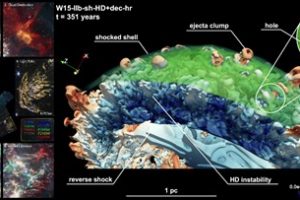About the nature of the green monster in the supernova remnant Cas A

A new theoretical study shows that the holes in the structure observed by the James Webb Space Telescope called “Green Monster” within the Cassiopeia A (Cas A) supernova remnant is due to the interaction between a pre-existing layer of circumstellar material, impacted by the supernova shock wave, and elongated stellar fragments produced by hydrodynamic instabilities.
Supernova remnants are objects of great interest both for the study of extreme physical processes and for understanding what happens inside and around a massive star in the final moments of its life, as it explodes into a supernova. This is particularly true for supernova remnants younger than 1000 years, which provide crucial information on the mechanisms at play during the explosion, the role of asymmetries in the progenitor and its circumstellar medium, and nucleosynthesis processes. Cas A is one of the few known remnants this young and holds a special place due to its recent formation: it was produced by a supernova that exploded just 350 years ago.
Given its importance, it is no surprise that Cas A was one of the first supernova remnants observed by NASA and ESA’s James Webb Space Telescope (JWST). These observations have revealed unprecedented details and have been the subject of already published studies as well as several press releases. One of the most striking features of Cas A, revealed by the JWST, is the presence of a structure with intense emission in the near-infrared (specifically at 10 and 11.3 microns), characterized by a series of holes with angular sizes ranging from 1 to 3 arcseconds. This structure has been dubbed the “Green Monster” due to its distinctive green color in the false-color JWST images released in the initial press statements.
Simulations of Cas A evolution, conducted years before the JWST observations by a team of supernova remnant experts at our observatory, had already predicted the possible existence of structures similar to the Green Monster. However, those simulations lacked the necessary spatial resolution to reproduce the details observed by JWST and did not fully explore all the physical processes involved. For this reason, a team of researchers led by astrophysicist S. Orlando (INAF – Astronomical Observatory of Palermo) conducted a new theoretical study on the nature of the Green Monster, based on existing simulations that track the evolution of Cas A from the stellar core collapse.
In this study, the existence of a layer of circumstellar material is considered, produced between 10,000 and 100,000 years before the supernova explosion as a result of a violent stellar eruption, and its compression due to the main shock wave of the supernova. Additionally, radiative cooling processes (i.e., the dispersion of energy in the form of radiation) are included, which, for the first time, are calculated in a self-consistent manner, taking into account deviations from thermal equilibrium between ions and electrons, deviations from ionization equilibrium, and the chemical composition of the emitting material. These processes further promote the compression of stellar atmosphere fragments expelled by the supernova and expanding within the supernova remnant (the ejecta). The hole-like structure is thus the result of the interaction between the circumstellar medium layer and the ejecta.
The physical model presented in this study therefore rules out the possibility that the hole structures observed by JWST formed within the circumstellar medium layer before interacting with the supernova shock wave, as a consequence of stellar fragments expelled at extremely high velocities during the explosion. Instead, these structures arise from the interaction with elongated fragments generated by hydrodynamic instabilities that develop between the direct shock wave and the circumstellar medium.
The study is presented in the article:“Origin of holes and rings in the Green Monster of Cassiopeia A: Insights from 3D magnetohydrodynamic simulations“, recently published in the journal Astronomy and Astrophysics.
Figure Description
The image (click here to view in full) shows one of the 3D models describing the interaction between the ejecta and the Green Monster, reproducing its characteristics. The color scheme represents different material velocities and densities, as indicated by the scales.
🔹 Shocked shell → The layer of compressed material impacted by the shock wave.
🔹 Ejecta clump → The fragments interacting with the layer.
🔹 Hole & Ring → Holes in the Green Monster with their surrounding halos, similar to those observed by JWST.
🔹 Reverse shock → The inward-moving shock wave affecting the inner region of the supernova remnant.
🔹 HD instability → The hydrodynamic instability responsible for forming the elongated fragments interacting with the Green Monster.
The bottom scale bar represents 1 parsec (approximately 3.3 light-years).
Mario Giuseppe Guarcello
Follow MarioSpiegaCose on Instagram () , Facebook (), Youtube (), and X ()
Follow the Astronomical Observatory of Palermo on Facebok and on Instagram
Subscribe the Youtube channel of the Astronomical Observatory of Palermo
